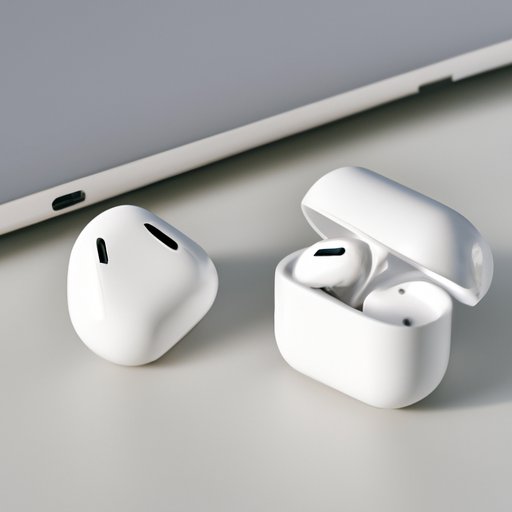
Introduction
Pairing Apple AirPods with MacBook can be frustrating for some users since it requires a few specific steps for a successful connection. However, once you complete the pairing process, you can effortlessly switch between your audio devices and enjoy an uninterrupted audio experience. This article provides a step-by-step guide on how to pair AirPods with MacBook, troubleshoot common issues, and effectively use the audio device for an enhanced listening experience.
Step-by-Step Guide
To pair AirPods with MacBook, you must first activate Bluetooth on both devices. Then, follow these simple steps:
- Open the case of your AirPods and ensure they are turned on and charged.
- On your MacBook, go to the Apple menu and select System Preferences.
- Click on Bluetooth and ensure it is turned on.
- Hold down the button on the back of the AirPods case until the status light starts blinking white.
- On your MacBook, you will see AirPods appear on the list of devices. Click Connect.
- Click Pair in the pop-up window that appears.
It’s important to follow these steps carefully. Make sure your AirPods and MacBook are close to each other and unobstructed during the pairing process. You may have to click the Connect button several times if the connection fails to establish.

Troubleshooting Guide
Despite following the pairing process, you may face issues connecting your AirPods to MacBook. You may experience one of the following issues:
- AirPods do not appear on the list of devices.
- Connection lost.
- Low sound quality.
If you encounter any of these issues, follow these helpful troubleshooting tips:
- Ensure that your MacBook and AirPods are up-to-date.
- Ensure that your MacBook and AirPods are not connected to any other devices.
- Ensure that your AirPods are in their case and charged.
- Try resetting your AirPods by holding down the button on the back of the case for at least 15 seconds until the status light flashes amber and then white.
- Try resetting your MacBook Bluetooth settings by holding down Shift + Option and clicking on the Bluetooth icon in the menu bar.
Benefits of AirPods
AirPods offer several unique features that enhance the user experience, including:
- Seamless switching between devices with the same Apple ID.
- Easy connectivity with other Apple devices, including iPhone and iPad.
- Hands-free access to Siri for managing your audio experience.
- Long battery life, allowing for extended use throughout the day.
Overall, AirPods provide a convenient and easy-to-use audio experience for MacBook users.
Comparison Guide
When comparing AirPods to other types of wireless headphones and laptops, AirPods offer several advantages when paired with a MacBook, including:
- Ability to seamlessly switch between MacBook and other Apple devices with the same Apple ID.
- Compatibility with other Apple features, including Siri and Handoff.
- Easy connectivity without the need for additional software or cables.
Frequently Asked Questions
Here are some frequently asked questions with answers on how to pair AirPods with MacBook:
Q: Why won’t my AirPods connect to my MacBook?
A: Ensure that both your MacBook and AirPods are up-to-date, charged, and unobstructed during the pairing process. If you still experience issues, try resetting your AirPods and MacBook Bluetooth settings.
Q: Can I connect AirPods to my MacBook without using the charging case?
A: No, you must use the charging case to connect your AirPods to MacBook.
Q: Can I connect AirPods to multiple MacBooks?
A: Yes, you can connect AirPods to multiple MacBooks with the same Apple ID.
Q: How do I turn off AirPods when they are connected to MacBook?
A: You can turn off AirPods by placing them in their charging case or going to System Preferences>Bluetooth on your MacBook and clicking Disconnect.
Conclusion
Pairing AirPods with MacBook require specific steps, but it is a simple process that can enhance your audio experience. Follow the step-by-step instructions to connect your AirPods to your MacBook, and use the troubleshooting tips to resolve any issues. AirPods offer several benefits when paired with MacBook, including easy connectivity, long battery life, and compatibility with Apple features.




